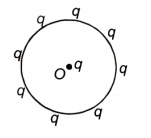A particle A has charge +q and another particle B has charge +4q with each of them having the same mass m. When allowed to fall from rest through the same electric potential difference, the ratio of their speeds will become:
1. 1: 2
2. 2: 1
3. 1: 4
4. 4: 1
If \(50~\text{J}\) of work must be done to move an electric charge of \(2~\text{C}\) from a point where the potential is \(-10~\text {volts}\) to another point where the potential is \(\text{V volts}\), then the value of \(\mathrm{V}\) is:
1. \(5~\text {volts}\)
2. \(-15~\text {volts}\)
3. \(+15~\text {volts}\)
4. \(+10~\text {volts}\)
A proton has a mass kg and a charge C. If the proton is accelerated through a potential difference of 1 million volts, then the kinetic energy is:
1.
2.
3.
4.
Calculate the work done in taking a charge C from A to B via C. (in the diagram)

1. 0.2 joule
2. 1.2 joule
3. 2.2 joule
4. Zero
Two electrons are moving towards each other, each with a velocity of m/s. What will be the closest distance of approach between them?
1.
2.
3.
4. Zero
A point charge q is surrounded by eight identical charges at distance r as shown in the figure. How much work is done by the forces of electrostatic repulsion when the point charge at the centre is removed to infinity?

1. Zero
2.
3.
4.
1000 small water drops, each of capacitance C, join together to form one large spherical drop. The capacitance of the bigger sphere is:
1. C
2. 10C
3. 100C
4. 1000C
Two similar conducting balls having charges +q and -q are placed at a separation d from each other in the air. The radius of each ball is r and the separation between their centres is d(d>>r). Calculate the capacitance of the two-ball system.
1.
2.
3.
4.
Two parallel plate capacitors have their plate areas 100 cm2 and 500 cm2 respectively. If they have the same charge and potential and the distance between the plates of the first capacitor is 0.5 mm, then the distance between the plates of the second capacitor is:
1. 0.10 cm
2. 0.15 cm
3. 0.20 cm
4. 0.25 cm
A dielectric slab of dielectric constant K is placed between the plates of a parallel plate capacitor carrying charge q. The induced charge q' on the surface of the slab is given by:
1.
2.
3.
4.







